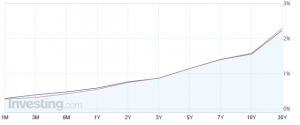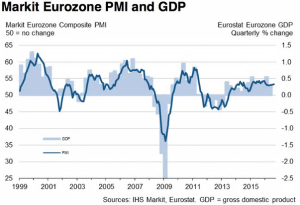Global Macro
Last Friday’s US Non-Farm Payroll data were unspectacular in the sense that they offered investors little clarity about the likelihood of a rate hike at the FOMC meeting on September 21st. The Headline jobs growth printed at 151,000, which was lower than the consensus 180,000, wage growth slowed to .1% and the unemployment rate was unchanged at 4.9%.
The US Dollar was sold off initially but regained bids mid-session and finished stronger by the holiday shortened NY close. The USD’s resilience in the face of the disappointing jobs data reflects the feeling that the report didn’t alter the FED’s information set, or sway investor sentiment very much for another move to normalize rates either this month or in December.
As a result, the SP 500 posted another firm close above the 30 day moving average at 2172.00, the US 10-yr note yield inched back over 1.60% and the US Dollar index close above recent resistance at 95.50.
In short, over the last two weeks, the primary market drivers have been about the US monetary policy trajectory. First, it was the Jackson Hole confab where the FED leadership all confirmed they were reading from the same “data-dependent” playbook. They all signalled the time was approaching to take another step in the normalization of interest rates, without specifying exactly when. Then, the market focused on the US Jobs report; which FED Vice-Chairman Stanley Fischer had identified as important to the timing of the next move.
With those US-centric events and information absorbed into the market, we believe that this week’s European Central Bank (ECB) policy meeting (and press conference) will be the primary driver for foreign exchange flows.
In addition to the usual discussions about the path of EU monetary policy, this Thursday’s meeting will also include updated staff economic forecasts. Aside from the uncertain political nuances of these staff forecasts, two points are patently clear: the EU economy doesn’t have much forward momentum from Germany and inflation remains well below the 2% target throughout the entire region.
We expect the ECB chief Mario Draghi to take direct aim at these two lingering issues and probably add comments about slowing exports due to the UK decision to leave the EU back in June. Of the additional stimulus measures on the table, the extension of the current Quantitative Easing (QE) program beyond March 2017 appears to be the decision of least resistance.
Other changes to the current asset purchase program include removing the interest rate floor on the securities pool so the ECB could buy assets which yield LESS than -.40% , cutting the ECB deposit rate deeper into to negative territory and expanding the total purchase amount above the current €1.7 trillion. On balance, we feel that there is little political or economic appetite for lowering the ECB base rate deeper into negative territory and that expanding toward a QE3 program is a more likely way of lowering the Euro and supporting EURO zone stock markets.

